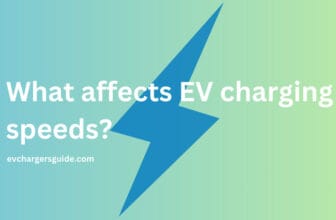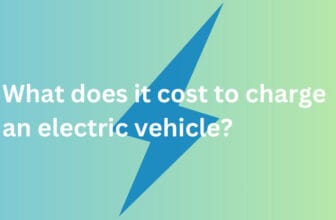
If you are new to EV world and looking at how to charge EV, then let me say charging your EV is so simple that it is almost similar to how you charge your phone! Yes.
I have made step by step process to charge an EV. You just need to follow the below simple steps and that’s it..!
You can follow the same steps to charge your EV at home charging station, in appartment or public charging station.
In This Article:
Here, I have given main steps involving in charging an EV, later I have explained each main steps in detail with all the things to take care of so that you won’t face any issues while you do it and also it becomes easy for you to charge an EV, like as easy as charging your phone!
Main Steps to Charge an EV
- Park your EV near a charging station
- Pull the charging cable from the station
- Hold the charging connector in your hand and take it to the charge port of your EV
- Open the charge port
- Plug in the connector in charge port
- Thats all! Now your EV will start to charge
- Wait for charging to complete
- Unplug the charger from charge port
- In case of home charging – You’re done
- In case of charging at public charger – pay for the charging session
That’s all now your EV is ready to shoot on the road!
Now, here are the detailed instructions to be followed at each step to avoid any difficulties in charging.
Detailed instructions to charge an EV
Else you need to pull in from over the car or from behind. This makes a little difficult job for you, especially at public chargers where charging cables are thick, less pliable and heavy.
Or if the cable is short (Which probably the case in public chargers) then you can just hold the connector and pull the cable from station.
For home chargers, cables are long enough and lighter than public stations. So it’s easy for you to hold the connector in one hand and pull the cable.
If the charge port is in front of the station then it will be easier to draw the cable to the port.
Otherwise, you have to take it from above the car or from behind or front depending on the location charge port in your car. This may put some scratches on the body of your car, so it’s better to avoid parking the car that way.
But in case of most public charging station, you may need to start charging manually from a phone app or from charging stall or by scanning RFID card or credit/debit card at the stall depending on the public charging network you use.
In the meantime, you can just sit or stand there or roam around or have coffee or a drink!. Or just rest in your EV, watch a movie or play a game..
If you’re at home then you can just now forget about charging and do your work or spend time with your family.
You will get a notification in your phone app if you’re using one for your EV or EV charger once charging is done. Or it will just stop charging once done. So nothing to worry about.
Or if you are using in apartment or condo and have RFID enabled then payment will automatically cut from your account.
If you’re charging at public charger then payment will be cut from respective payment method you used before starting charging session, either from payment method you have added in your account you made for that charging network, from phone app, credit/debit card or RFID card.
Or you may have a subscription plan and cost is added to your account depending on the plan.
Now let me tell you some important things you should consider charging your EV for the first time. Also, these are the things that most EV owners face the problem with while charging and they end up searching on Google ‘My EV is not charging what to do..!’
So take these things in your mind to avoid facing the problem.
Important Things to Consider While Charging an EV
1) Charging with a different type of connector not compatible with charge port type
If the connector type at the end of charging connector is not a match with the charging port type then you have to use a converter called charging adapter in between. It will convert the connector type of station to that of EV’s charge port.
e.g. If your EV’s charge port is J1772 type 1 and charging station is of Tesla with NACS connector then you need to have NACS to J1772-type 1 adapter. So fix the adapter over the connector at the end of charging cable and then plug-in the another end of adapter to charge port.
2) Enabled scheduled charging
If scheduled charging is enabled in your EV from the dashboard or from any phone app then out of that scheduled time charging won’t start automatically. Either you have to modify or delete the schedule or override it.
Also, schedule can be set up from side of EV charger. Public charger won’t have any schedule but in case of home charging if scheduled time is set up then again you have to modify or delete the schedule or override it if you want to charge out of scheduled time.
The process of modifying, deleting or overriding is different with different EVs and EV chargers. So check in the respective user manual.
3) Enabled charge limit
Now, one more thing is there are charge limit settings in every Electric Vehicle. It means you can limit the maximum charging to fill up an EV’s battery by setting a charge percentage limit either in EV’s dashboard or from EV’s app.
Now what happens is many times EVs automatically set charge limit to 80% considering battery health. And when you charge your EV will stop charging once it reaches 80% charge level. And you then think why it’s not charging fully?
If you don’t know about 20 80 rule in EV charging then you should know this. Here are the instructions on how much to charge an EV.
Also, many EV owners forget about charge limit they have set and next time them again come to this question why my EV is not charging beyond this percentage?
You can change the charge limit, either increase it, decrease it or disable it depending on the EV you use.
So to avoid this issue you should have knowledge about this function in Electric Vehicle. So that you don’t boggle while charging your EV at in between the highway at public station or at your home hurrying to depart somewhere. And if you face some issue caused by charge limit then you can quickly fix it.
So these were the steps and things to consider while charging your EV.
I hope now you are clear about the process of charging an EV.
Let me know in the comments if you have any confusion.
See you in the next article!

![What is the cost to install Tesla charger at Home? [Detailed Guide]](https://evchargersguide.com/wp-content/uploads/2023/12/how-much-does-it-cost-to-install-tesla-home-charger.jpg)
















oh it’s easier than I thought.. cool
Welcome to EV world, it’s not difficult as it seems!
I have to know about adapters now. I didn’t knew about difference types of ports and connectors.